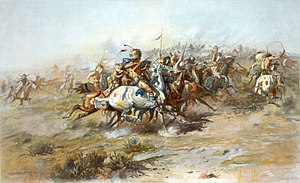Battle of the Little Bighorn
| The Battle of the Little Bighorn | |||||||
|---|---|---|---|---|---|---|---|
| Part of The Great Sioux War of 1876 | |||||||
 The Custer Fight by Charles Marion Russell |
|||||||
|
|||||||
| Belligerents | |||||||
|
Lakota Dakota Northern Cheyenne Arapaho |
|
||||||
| Commanders and leaders | |||||||
|
Sitting Bull Crazy Horse Chief Gall Lame White Man † Two Moon |
|
||||||
| Units involved | |||||||
| Irregulars | 7th Cavalry Regiment | ||||||
| Strength | |||||||
| 900–2,500 | 647 | ||||||
| Casualties and losses | |||||||
| Most likely 31 warriors, 6 women, 4 children killed up to 160 wounded |
268 killed 49 wounded+6 Died of wounds |
||||||
|
|
|||||||
The Battle of the Little Bighorn, known to the Lakota and other Plains Indians as the Battle of the Greasy Grass and commonly referred to as Custer's Last Stand, was an armed engagement between combined forces of the Lakota, Northern Cheyenne, and Arapaho tribes and the 7th Cavalry Regiment of the United States Army. The battle, which occurred June 25–26, 1876, near the Little Bighorn River in eastern Montana Territory, was the most prominent action of the Great Sioux War of 1876.
The fight was an overwhelming victory for the Lakota, Northern Cheyenne, and Arapaho, led by several major war leaders, including Crazy Horse and Chief Gall, inspired by the visions of Sitting Bull (Tȟatȟáŋka Íyotake). The U.S. 7th Cavalry, including the Custer Battalion, a force of 700 men led by George Armstrong Custer, suffered a major defeat. Five of the 7th Cavalry's twelve companies were annihilated; Custer was killed, as were two of his brothers, a nephew, and a brother-in-law. The total U.S. casualty count included 268 dead and 55 severely wounded (six died from their injuries later), including four Crow Indian scouts and two Pawnee Indian scouts.
Public response to the Great Sioux War varied in the immediate aftermath of the battle, but over the next years and decades Custer and his troops became iconic, heroic figures in American history, a status that lasted into the 1960s. The battle, and Custer's actions in particular, have been studied extensively by historians.
Tension between the native inhabitants of the Great Plains of the United States and the encroaching white European settlers in the latter half of the 19th Century resulted in a series of conflicts known as the Sioux Wars, which took place between 1854 and 1890. Even though many of the native peoples eventually agreed to relocate to ever-shrinking reservations, a number of them resisted, at times fiercely.
...
Wikipedia

